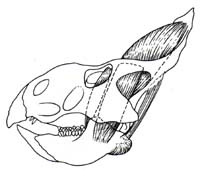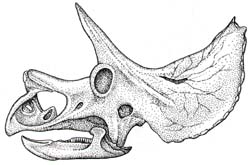|
Horns
and Frills:
 Contrary
to popular belief, the horns and frill structures of the
ceratopsians were not primarily for defensive purposes. In
fact these structures were quite versatile. For example,
the frill contained the muscles controlling jaw movement,
and different shapes and sizes probably reflected
differences in jaw muscles (Lucas, 1994). Contrary
to popular belief, the horns and frill structures of the
ceratopsians were not primarily for defensive purposes. In
fact these structures were quite versatile. For example,
the frill contained the muscles controlling jaw movement,
and different shapes and sizes probably reflected
differences in jaw muscles (Lucas, 1994).
 The
frill also probably served as a visual display along with
the horns and may have expressed sexual dimorphism (Lucas,
1994). The
frill also probably served as a visual display along with
the horns and may have expressed sexual dimorphism (Lucas,
1994).
 Another
possible function of the frill was as a thermoregulator.
They were highly vascularized, spreading the blood over a
wide surface area, and thus allowing rapid heating and
cooling. Consequently, the frill may not have been used as a
shield in combat, for it was probably quite vulnerable. Another
possible function of the frill was as a thermoregulator.
They were highly vascularized, spreading the blood over a
wide surface area, and thus allowing rapid heating and
cooling. Consequently, the frill may not have been used as a
shield in combat, for it was probably quite vulnerable.
 The
horns may have served some defensive function, but their use
primarily in display, and interspecies competition seems
more likely (Lucas, 1994). The
horns may have served some defensive function, but their use
primarily in display, and interspecies competition seems
more likely (Lucas, 1994).
|
 (Sims,
1994) (Sims,
1994)
The
frills of ceratopsians provided sites for the attachment of
jaw muscles.
 (Sims,
1994) (Sims,
1994)
Differences
in skull size and shape may have distinguished male and
female Protoceratops.
 (Sims,
1994) (Sims,
1994)
The
frill of Triceratops was highly vascularized, covered
with channels and grooves for the blood
vessels.
|